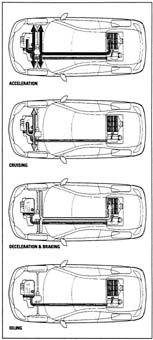
The Insight's IMA system owes much of its remarkable performance to the application of numerous technologies developed by Honda over the past four decades, including lean-burn combustion, low-emission engines, variable valve timing, high-efficiency electric motors, regenerative braking, nickel-metal hydride battery technology and microprocessor control. In the IMA system, Honda engineers have optimized the performance of each of these technologies to create an efficient, lightweight and compact hybrid drive system that people can easily use and that does not require any changes in lifestyle. Here's how it works:
Primary motive power for the Insight is provided by the system's 1.0-liter, 12-valve, 3-cylinder, VTEC-E gasoline engine. Although the engine alone provides sufficient driving performance, even in sustained uphill driving, a permanent-magnet electric motor mounted between the engine and transmission provides power assistance under certain conditions, such as initial acceleration from a stop. And since the electric motor is used only for power assistance and not for primary motive power, it too can be made smaller and lighter relative to the full-size traction motors in other hybrid systems.

As the IMA gasoline engine enters its mid- to high-rpm operating range, the electric motor assist ceases and power is solely supplied by the engine, which is operating in its high-rpm 4-valve mode.
Power for the electric motor comes mainly by recapturing energy from the forward momentum and braking of the vehicle, rather than from the gasoline engine. When the Insight is coasting or its brakes are applied, and the vehicle is in gear, its electric-assist motor becomes a generator, converting forward momentum into electrical energy, instead of wasting it as heat during conventional braking (vented front disc/rear drum brakes are still the main means of braking). If the charge state of the IMA battery is low, the motor/generator will also recharge while the Insight is cruising; however, the advantage of regenerative braking is that it eliminates the need for a large, on-board electrical generating system, like the ones used on most parallel hybrid gasoline-electric drivetrains.
This beneficial spiral of decreasing weight, reduced size and complexity and increased performance continues with the IMA nickel-metal hydride battery pack (a technology Honda pioneered in its EV PLUS electric car), which is also smaller and lighter in weight than the ones used in other hybrid systems. The batteries are located under the cargo compartment floor, along with the IMA system's Power Control Unit (PCU).
The IMA electric motor also functions as a high-rpm starter motor.
Compared to a comparable internal-combustion-powered drivetrain, like that in a Honda Civic, the Insight's IMA system boasts an impressive 24-percent improvement in efficiency in combined-mode city and highway driving, while meeting California's stringent Ultra-Low Emission Vehicle (ULEV) standard.